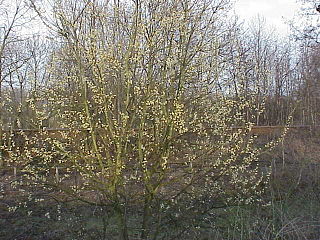
Metrosideros bartlettii, also known as Bartlett's rātā, Cape Reinga white rātā or in Māori as Rātā Moehau, is one of twelve Metrosideros species endemic to New Zealand and is notable for its extreme rarity and its white flowers, somewhat uncommon in that genus of red-flowered trees and plants. Its natural range is in the far north of the North Island at Te Paki, in three patches of dense native forest near Spirits Bay that escaped destruction by fire, namely Radar Bush, Kohuronaki Bush, and Unuwhao Bush. Only 25 adult trees are known to exist in the wild and most of these are either ill or dying. The lack of fossil evidence elsewhere suggests that the tree may always have been restricted to the North Cape area, which was an island until it was connected to the mainland by the sandspit that constitutes Ninety Mile Beach.
Cryosophila bartlettii is a species of flowering plant in the Arecaceae family. It is found only in Panama.
Casearia albicans is a species of plant in the Salicaceae family. It is a tree endemic to Peninsular Malaysia. It is threatened by habitat loss.

Casearia is a plant genus in the family Salicaceae. The genus was included in the Flacourtiaceae under the Cronquist system of angiosperm classification, and earlier in the Samydaceae. Recent research indicates that the latter group might be reinstated as a valid family.
Casearia atlantica is a species of plant in the Salicaceae family. It is endemic to Panama. It is threatened by habitat loss.
Casearia crassinervis is a species of plant in the Salicaceae family. It is endemic to Cuba.
Casearia engleri is a species of plant in the Salicaceae family. It is endemic to Tanzania.
Casearia flavovirens is a species of plant in the Salicaceae family. It is found in Java and Bali in Indonesia. It is a vulnerable species threatened by habitat loss.
Casearia kaalaensis is a species of plant in the Salicaceae family. It is endemic to New Caledonia.
Casearia macrocarpa is a species of plant in the Salicaceae family. It is a tree endemic to Peninsular Malaysia. It is threatened by habitat loss.
Casearia mannii is a species of plant in the Salicaceae family. It is endemic to São Tomé and Príncipe, where it is restricted to the island of Príncipe. It is listed as vulnerable by the IUCN.
Casearia mauritiana is a species of plant in the Salicaceae family. It is endemic to Mauritius.
Casearia megacarpa is a species of plant in the Salicaceae family. It is endemic to Colombia.
Casearia quinduensis was a species of plant in the Salicaceae family. It was endemic to Colombia.
Casearia tinifolia was a species of plant in the Salicaceae family. It was endemic to Mauritius.
Casearia williamsiana is a species of plant in the Salicaceae family. It is endemic to Honduras.
Casearia wynadensis is a species of plant in the Salicaceae family. It is native to Kerala and Tamil Nadu in India.
Casearia sylvestris is a Brazilian herb in the Salicaceae family. It is catalogued by the Brazilian Unified Health System as a plant of interest for the Brazilian population with the purpose of treating inflammatory disorders.

Harley Harris Bartlett was an American botanist, biochemist, and anthropologist. He was an expert in tropical botany and an authority on Batak language and culture. The standard author abbreviation Bartlett is used to indicate this person as the author when citing a botanical name.
Caladenia bartlettii is a plant in the orchid family Orchidaceae and is endemic to New Zealand. It is a ground orchid with a single narrow, hairy leaf and a thin wiry stem usually bearing one short-lived mauve to pink flower.



